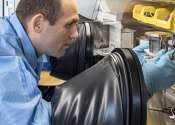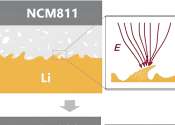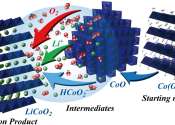Lithium (pronounced /ˈlɪθiəm/) is the chemical element with atomic number 3, and is represented by the symbol Li. It is a soft alkali metal with a silver-white color. Under standard conditions it is the lightest metal and the least dense solid element. Like all alkali metals lithium is highly reactive, corroding quickly in moist air to form a black tarnish. For this reason lithium metal is typically stored under the cover of oil. When cut open lithium exhibits a metallic luster, but contact with oxygen quickly turns it back to a dull silvery gray color. Lithium in its elemental state is highly flammable.
According to theory, lithium was one of the few elements synthesized in the Big Bang. Since its current estimated abundance in the universe is vastly less than that predicted by theory; the processes by which new lithium is created and destroyed, and the true value of its abundance, continue to be active matters of study in astronomy. The nuclei of lithium are relatively fragile: the two stable lithium isotopes found in nature have lower binding energies per nucleon than any other stable compound nuclides, save for the exotic and rare deuterium, and 3He. Though very light in atomic weight, lithium is less common in the solar system than 25 of the first 32 chemical elements.
Due to its high reactivity it only appears naturally in the form of compounds. Lithium occurs in a number of pegmatitic minerals, but is also commonly obtained from brines and clays. On a commercial scale, lithium metal is isolated electrolytically from a mixture of lithium chloride and potassium chloride.
Trace amounts of lithium are present in the oceans and in some organisms, though the element serves no apparent vital biological function in humans. However, the lithium ion Li+ administered as any of several lithium salts has proved to be useful as a mood stabilizing drug due to neurological effects of the ion in the human body. Lithium and its compounds have several industrial applications, including heat-resistant glass and ceramics, high strength-to-weight alloys used in aircraft, and lithium batteries. Lithium also has important links to nuclear physics. The transmutation of lithium atoms to tritium was the first man-made form of a nuclear fusion reaction, and lithium deuteride serves as a fusion fuel in staged thermonuclear weapons.









